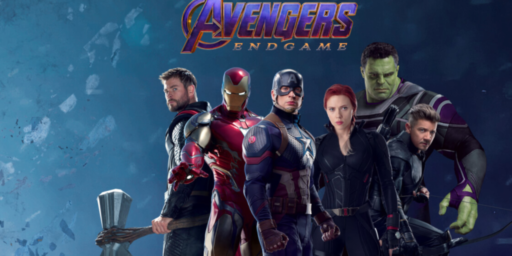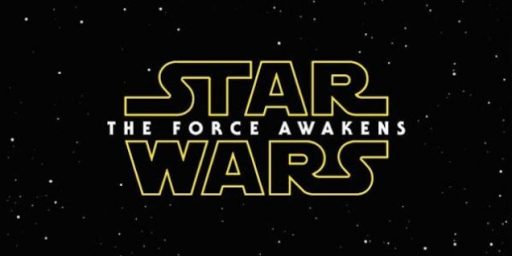‘Black Panther’ Breaks Bogus Box Office Benchmark
The Marvel superhero film passed 'Titanic' in US ticket sales. Unless we adjust for inflation. Which we absolutely should.
HuffPost (“‘Black Panther’ Sinks ‘Titanic’ At Box Office; Twitter Goes Full Steam Ahead“):
“Black Panther” has officially sailed past “Titanic” to become third in the rankings for America’s top-grossing film of all time.
The Marvel blockbuster overtook James Cameron’s 1997 smash hit on Saturday, when it surpassed $665 million at the domestic box office. It’s now the highest-grossing title at the North American box office after 2015-s “Star Wars: The Force Awakens” ($936.7 million), and 2009-s “Avatar” ($760.5 million).
These figures haven’t been adjusted for inflation. Doing that would mean “Gone With The Wind” is the highest-grossing film of all time. But we digress.
“Black Panther” has grossed $1.29 billion worldwide since its release, and people can’t stop showing love for the film.
This is followed by a collection of random tweets because, hey, journalism.
“Black Panther” was a really good movie, and something of a cultural milestone. But the digression is what interests me. It’s obviously silly to rank movies by gross dollar sales, yet we continue to do it for no apparent reason. According to Box Office Mojo, here are the top-ranked films on an inflation-adjusted basis:
DOMESTIC GROSSES
Adjusted for Ticket Price Inflation*
Note: This chart only shows the top 300 movies, regardless of sorting.
| Rank | Title (click to view) | Studio | Adjusted Gross | Unadjusted Gross | Year^ |
| 1 | Gone with the Wind | MGM | $1,854,769,700 | $198,676,459 | 1939^ |
| 2 | Star Wars | Fox | $1,635,137,900 | $460,998,007 | 1977^ |
| 3 | The Sound of Music | Fox | $1,307,373,200 | $158,671,368 | 1965 |
| 4 | E.T.: The Extra-Terrestrial | Uni. | $1,302,222,800 | $435,110,554 | 1982^ |
| 5 | Titanic | Par. | $1,244,347,300 | $659,363,944 | 1997^ |
| 6 | The Ten Commandments | Par. | $1,202,580,000 | $65,500,000 | 1956 |
| 7 | Jaws | Uni. | $1,175,763,500 | $260,000,000 | 1975 |
| 8 | Doctor Zhivago | MGM | $1,139,563,500 | $111,721,910 | 1965 |
| 9 | The Exorcist | WB | $1,015,300,400 | $232,906,145 | 1973^ |
| 10 | Snow White and the Seven Dwarfs | Dis. | $1,000,620,000 | $184,925,486 | 1937^ |
| 11 | Star Wars: The Force Awakens | BV | $992,496,600 | $936,662,225 | 2015 |
| 12 | 101 Dalmatians | Dis. | $917,240,400 | $144,880,014 | 1961^ |
| 13 | The Empire Strikes Back | Fox | $901,298,200 | $290,475,067 | 1980^ |
| 14 | Ben-Hur | MGM | $899,640,000 | $74,000,000 | 1959 |
| 15 | Avatar | Fox | $893,301,900 | $760,507,625 | 2009^ |
| 16 | Return of the Jedi | Fox | $863,465,400 | $309,306,177 | 1983^ |
| 17 | Jurassic Park | Uni. | $841,088,300 | $402,453,882 | 1993^ |
| 18 | Star Wars: Episode I – The Phantom Menace | Fox | $829,064,800 | $474,544,677 | 1999^ |
| 19 | The Lion King | BV | $818,364,200 | $422,783,777 | 1994^ |
| 20 | The Sting | Uni. | $818,331,400 | $156,000,000 | 1973 |
| 21 | Raiders of the Lost Ark | Par. | $812,675,900 | $248,159,971 | 1981^ |
| 22 | The Graduate | AVCO | $785,595,300 | $104,945,305 | 1967^ |
| 23 | Fantasia | Dis. | $762,339,100 | $76,408,097 | 1941^ |
| 24 | Jurassic World | Uni. | $725,671,700 | $652,270,625 | 2015 |
| 25 | The Godfather | Par. | $724,509,200 | $134,966,411 | 1972^ |
| 26 | Forrest Gump | Par. | $721,682,300 | $330,252,182 | 1994^ |
| 27 | Mary Poppins | Dis. | $717,709,100 | $102,272,727 | 1964^ |
| 28 | Grease | Par. | $706,577,200 | $188,755,690 | 1978^ |
| 29 | Marvel’s The Avengers | BV | $705,769,500 | $623,357,910 | 2012 |
| 30 | Thunderball | UA | $686,664,000 | $63,595,658 | 1965 |
| 31 | The Dark Knight | WB | $683,575,000 | $534,858,444 | 2008^ |
| 32 | The Jungle Book | Dis. | $676,381,600 | $141,843,612 | 1967^ |
| 33 | Sleeping Beauty | Dis. | $667,166,200 | $51,600,000 | 1959^ |
| 34 | Black Panther | BV | $665,630,708 | 2018 | 1959^ |
| 35 | Ghostbusters | Col. | $653,374,800 | $242,212,467 | 1984^ |
We see that “Blank Panther” is currently in the #34 spot—which is still awfully good—and likely to climb quite a bit further. On the other hand, it’s just two spots ahead of “Shrek 2.”
Even inflation adjustment doesn’t make the comparisons perfect. The advent of various film formats with different pricing schemes—3D, IMAX, and the like—mean movies like “Black Panther” are often netting more even in real dollars per moviegoer than was possible in the days of “Gone with the Wind” or even “Titanic.” Box Office Mojo tries to also normalize for ticket prices, which strikes me as problematic since the comparison is indeed supposed to be revenue rather than viewership. The latter would also be skewed towards kid-friendly movies, since child’s tickets are typically cheaper, and could also encourage promotions ($1 ticket nights) to skew the attendance records.





It’s obviously silly to rank movies by gross dollar sales, yet we continue to do it for no apparent reason.
Thank you.
The statistics are clearly racist.
One thing worth noting about the top ranking for Gone With The Wind is the fact that it was apparently released in theaters several times after its initial debut in 1939.
According to Wikipedia, in addition to its release in 1939, it was also released in 1942, 1947. 1954, 1961, 1967, 1971, 1974, 1989, 1998, 2013, and 2014. Many of these re-releases coincided with adaptations to the film made possible by new technology such as changes in aspect ratio and advances such as 70mm film and digital technology. Some of the technological advancements that coincided with the re-releases are described at the Wikipedia link.
The Star Wars films, of course, have also been re-released in theaters as well.
I would be curious to know if the adjusted gross numbers account for the revenues generated by these re-releases.
It was re-released in 1942, 1947, 1954, 1967, 1974, 1989, and 1998 not to mention it being released for television. IIRC I first saw it in the theater during the 1954 re-release. TV re-runs weren’t as common in those days as they are now.
@Doug Mataconis:
Box Office Mojo only lists three separate releases for Gone with the Wind and also three for Star Wars. Not sure how the differentiate between the ones they list and the rest.
In the minds of most people the world over, “adjusted for inflation” is as meaningful as “eat dinosaur purple lunch.”
I have yet to see it — been swamped. But everyone I know who has loved it. Don’t know if you guys saw SNL’s “Black Jeopardy” with Boseman in character as T’challa but it was quite funny.
On the subject of box office, I found this to be a lot more interesting, The Fate of the Furious made $1.236 billion last year and Get Out made $255 million worldwide, yet, according to Deadline, Get Out had a higher net profit…
(And Get Out is swamped by The Last Jedi, that only made about $100 million more worldwide than The Fate of the Furious…)
At least with Gone With the Wind, it’s also interesting to remember that the population was about 40% as large as it is today, so that really must have been a blockbuster dwarfing anything we’ve ever seen. Then again, the competition for eyeballs was not nearly so fierce.
As I said a few weeks ago when this topic came up, I think the Hollywood press does this because it enables them to claim movies are constantly breaking all-time records. Adjust for inflation, and records get broken a lot less frequently.
James is 100% right that all comparisons should be adjusted for inflation, not just movies. With that said, I think it’s going to be hard for new movies to beat the old ones because we watch movies so differently now. When GWTW came out your choice was to watch in a movie theater or never see it. If you loved it and wanted to watch again you had to go back to the theater. Most theaters showed one A level movie per week and in the case of GWTW, that got carried over for multiple weeks. So there was no other choice. Today, theaters have 10-20 screens, so there are a lot more choices. If you want to rewatch a movie you might just wait until it shows up on HBO or Netflix, or the DVD comes out. In fact a huge section of the population only watch movies at home, which was not an option in the GWTW days.
Just to show how different the terrain is, if you adjust not just for inflation but for population size GWTW earned the equivalent of $4.6B dollars.
@Hal_10000:
I went in assuming it was being overpraised and came away a convert.
First, it’s beautiful, aesthetically. There are any number of establishing shots where you’ll wish you could freeze-frame just to explore the visuals. They imagined traditional African cultural elements modified and expanded upon, just as early European culture morphed over time. They postulated an African I.M. Pei and a Jonny Ive, and the result is really stunning.
Second, the screenplay is impressive at a technical level. It is inevitably burdened with huge piles of exposition, but it’s all done so organically you seldom notice. That screenplay carries backstory, political and moral subtleties, and still delivers on character. Nice work.
Third, the subtle way they used Martin Freeman. It is a spot-on, affectionate parody of every ‘the black guy’ role ever. I doubt many white audiences got it, but I’ll bet black audiences did.
And with all that it still has all the gleeful stoopidity of a superhero movie. It’s never not fun.
This isn’t tokenism, this isn’t white charity, this isn’t affirmative action, this is an amazing movie at every level. As were Moonlight and Get Out! It’s almost as if there’s something to this whole ‘let’s look beyond the same white dudes’ thing. These are three masterpieces.
So many other things you need to adjust for on this now really stale data. Like, who the heck goes to the movies anymore when I can wait a few months and it will be out on streaming or DVD. You did not have that option in the past and the wait was much longer, so you saw the movie in the theatre. It was also cheaper in the past when you adjust for inflation. a $3 ticket in the early 80’s is around $8 today and $8 is below what ticket prices actually are nowadays.
Just so many different factors overall, its kinda silly to keep doing this
@MarkedMan: @Jc: You’re right that it’s a very different concept nowadays, with multiplexes and huge, high quality screens at home. I watched almost all of the superhero movies of the last decade on the big screen, as the special effects films are really better experienced in a theater.
And, over the last 2-3 years, the girls have been at the age where they really like going, so we’ve seen most of the big kids-oriented flicks as well as the last few superhero and Star Wars movies in the theater together. We also buy a lot of those in Bluray to watch again at home since they’ll do that. Preferably, with a DVD included as a throw-in so that they can watch them in the back of the van.
Regardless of how we count the dollars, what I found somewhat amusing is that I have seen every single one of the 35 movies listed. Many several times.
Not adjusting for inflation, or population (or GDP). Same trick Republicans pull every time they pass the BIGGEST TAX CUT EVER.
@MarkedMan:
That’s a dynamic that lasted well into the ’70s, if not later. Which is why I saw Star Wars* 11 times on its first release…
*Yes, “Star Wars”. Not “Episode 4, the Retcon” or any other title.
What’s really striking about the adjusted list is just how huge Lucas, Spielberg and, later and to a lesser degree, Cameron are in the history of the industry. People still talk about how Jaws and Star Wars changed the American movie business — this is why…